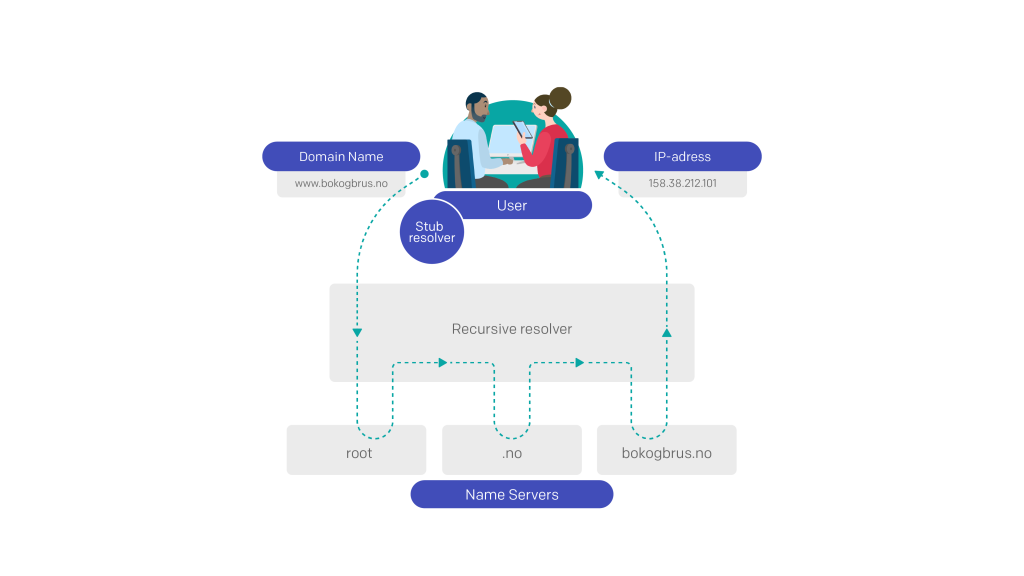Everyone who uses the internet, uses domain names to reach the services they desire. On this page you will find a simple introduction to how the domain name system, also known as the DNS, works.
For a user, the value of the internet lies in the services that run on the technical infrastructure. The most well known services are web pages and email, but you can also make video and telephone calls via the internet, download files, log onto various databases, control the heating in your house, and so on.
On the net, content is made available when a content provider uploads it to a server that is connected to the internet. When you visit a website, the content on the web page is sent to you from the server where it is hosted, via the internet. To gain access to content or other services on the internet, your computer must have the address to the server where the content is hosted or the service is offered. This address is found by lookups in the global domain name system (DNS).
Domain names provide human friendly addresses – it is easier to remember radio.nrk.no than 23.102.50.11.
Domain names and top-level domains
All devices connected to the Internet have their own unique IP address, which consist of a long sequence of numbers. The Domain Name System links IP addresses to unique domain names.
Examples of domain names many use daily: dagbladet.no, vg.no, google.com and facebook.com.
The last part of the domain name – its “last name” – is the top-level domain the domain name is registered under. There are two different types of top-level domains: country code top-level domains (such as .no or .se) and generic top-level domains (such as .com, .org or .shop).
What happens when you look up a domain name?
You can access a website in different ways: Click a link, use an app, follow hits from a search engine, or enter the URL into a browser. All these methods of access entail looking up a domain name. The same happens if you want to send an email to a given email address, or connect to other services that are offered via the internet.
The lookup initiates a search for an IP address used to contact the server operating the service you are requesting access to.
What happens behind the scenes when you look up a domain name?

Each domain name has a set of servers handling queries about addresses under the domain name in question. These servers are called name servers.
- A small application in your device contacts a dedicated server set up to handle queries in the domain name system, a so-called recursive resolver (often operated by your Internet service provider).
- The recursive resolver is tasked with finding the IP address of www.bokogbrus.no. It forwards the query to one of the name servers for the top level of the domain name system (called the root). Root name servers only know the level below them in the hierarchy, and therefore returns a list of name servers for the top-level domain .no.
- The resolver then forwards the query to one of the name servers for .no. These servers also only know the level below them, and therefore return a list of name servers for bokogbrus.no.
- The resolver repeats the query to one of the name servers for bokogbrus.no, which returns the IP address for www.bokogbrus.no.
- The resolver then forwards the IP address to your device. Once your browser is provided with the IP address, it contacts the web server at this address, and downloads the website you requested.
The video below illustrates how the domain name system works.
How the domain name system is organised
A domain name is a part of a hierarchical name structure. An internet address consists of several parts, where each part belongs to a separate level of the hierarchy.
The topmost level, the DNS root, is not a visible part of the address. The next level is the top-level domain, which is the last part of an internet address. For Norwegian domain names, the top-level domain is .no.
On the level under the top-level domain, is the domain name, e.g. vg.no, nrk.no or facebook.com.
On the level under the domain name, there are sub-level domains, like e.g. jd.dep.no used by the Norwegian Department of Justice and Public Security.
This hierarchical structure also mirrors the responsibilities involved. Different actors can be given responsibility for each level. The one who has a domain name can choose to establish sub-level domains under their domain name. NRK (The Norwegian Broadcasting Corporation) can thus freely create sub-level domains under nrk.no, like tv.nrk.no.
Each top-level domain has a registry that, through an agreement with the international administrator of top-level domains (ICANN), has the right to delegate, manage and register domain names under the top-level domain. The registry decides the terms for delegating domain names under their top-level domain, and maintains a register of who has the right to use each domain name. For .no, the registry is Norid.
A domain name is established when a legal or private person buys a subscription for the domain name, and gets assigned the right to use it. The domain name subscriber (registrant) is responsible for the use of the domain name.
More about domain names and the domain name system
The role of the domain name system in the production of internet services

